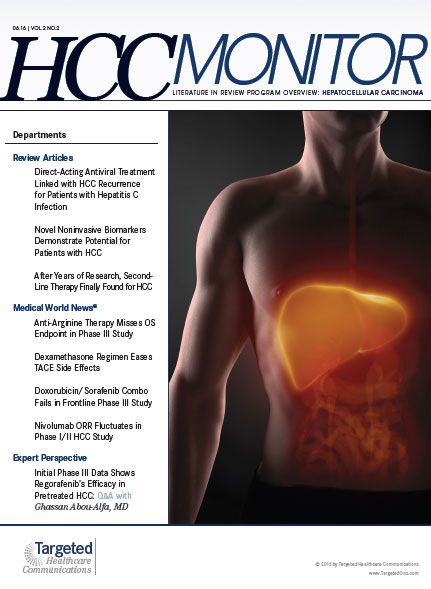Anti-Arginine Therapy Misses OS Endpoint in Phase III Study
Treatment with ADI-PEG20 did not demonstrate an improvement in overall survival compared with placebo for patients with advanced hepatocellular carcinoma.
In the study, median OS was 7.8 months with ADI-PEG20 (95% CI, 6.77-8.57) compared with 7.4 months with placebo (95% CI, 6.37-9.03; P = .884). Despite these disappointing results, subgroups of patients identified by biomarkers did appear to respond favorably to the treatment, specifically those with arginine depletion and citrulline increases.
"Single-agent ADI-PEG20 at 18 mg/m2did not demonstrate an improvement in survival versus placebo in HCC patients who have failed or are intolerant to sorafenib," said lead investigator Ghassan K. Abou-Alfa, MD, medical oncologist, Memorial Sloan Kettering Cancer Center. "Arginine depletion is a critical step for potential ADI-PEG20 exerted efficacy."
ADI-PEG20 is composed of a microbial enzyme arginine deiminase (ADI) and polyethylene glycol (PEG). ADI is crucial to cellular metabolism and growth, and once metabolized it releases citrulline and ammonia. Prior to initiation of the phase III study, phase I/II trials had shown promising results for patients with HCC and melanoma.
In the phase III study, 633 patients were randomized in a 2:1 ratio to receive ADI-PEG20 weekly at 18 mg/m2(n = 424) or placebo (n = 211). The median age of patients was approximately 61 years, and most were males (83%). Approximately half of patients were Asian (53%). Seventy percent of patients had failed prior treatment with sorafenib and 16% were sorafenib intolerant.
Most patients were infected with the hepatitis B virus (53%) or the hepatitis C virus (26%). Twelve percent of patients had alcohol-related HCC. The Child-Pugh score was A for 91% of patients in the study. Thirty percent of patients had vascular invasion and 75% had extrahepatic disease.
There were no complete responses in either arm. The partial response rate was 1% with ADI-PEG20 and 3% with placebo. The stable disease rate was 24% with ADI-PEG20 and 28% with placebo. Data were missing for approximately 22% of patients in each arm.
Those with arginine depletion for >7 weeks had a median OS of 12.5 months with ADI-PEG20 compared with 6.3 months for those with arginine depletion of ≤7 weeks (P <.0001). Similarly, those with a citrulline increase of >7 weeks had a median OS of 13 months with ADI-PEG20 versus 5.6 months in those with ≤7 weeks of citrulline increase (P <.0001).
In sorafenib pretreated patients, the median OS was 7.3 months with ADI-PEG20 versus 7.7 months with placebo (P = .469). For sorafenib-naïve individuals, the median OS was 6.5 months with ADI-PEG20 versus 5.7 months with placebo (P = .106).
“Whenever there is exposure to sorafenib, this was associated with an increase in ASS, which is the enzyme that will turn citrulline into arginine,” said Abou-Alfa. “This argues that prior sorafenib probably led to ASS increase.”
Patients in each arm received a median of 11 doses of treatment. The duration of exposure was 10 weeks, in the ADI-PEG20 arm. The most common grade ≥3 adverse events with ADI-PEG20 versus placebo, respectively, were anemia (4% vs 6%) and AST increase (10% vs 9%). All-grade skin toxicity (pruritus and rash) occurred in 35% of those in the ADI-PEG20 arm versus 26% of those in the placebo group.
The rate of grade 5 events were similar in each group, at 16% with ADI-PEG20 and 17% with placebo. One patient experienced cardiac arrest in the ADI-PEG20 arm. Additionally, patients experienced GI hemorrhage, liver failure, brain infarction/bleed, and respiratory failure at similar rates in each group.
References:
- Abou-Alfa GK, Qin S, Ryoo B-Y, et al. Phase III randomized study of second line ADI-peg 20 (A) plus best supportive care versus placebo (P) plus best supportive care in patients (pts) with advanced hepatocellular carcinoma (HCC).J Clin Oncol. 2016;34 (suppl; abstr 4017).

Rugo Surveys Peers on Treatment After Metastatic Relapse of HR+, HER2– Breast Cancer
April 20th 2024During a Case-Based Roundtable® event, Hope S. Rugo, MD, FASCO, moderated a discussion on treatment options for a patient whose breast cancer recurred several years after adjuvant therapy.
Read More
Peers Discuss Role of Pola-R-CHP vs R-CHOP in Newly Diagnosed DLBCL
April 19th 2024During a Case-Based Roundtable® event, Haifaa Abdulhaq, MD discussed with participants whether the POLARIX trial influences their choice to use the pola-R-CHP as opposed to R-CHOP regimen for patients with newly diagnosed diffuse large B-cell lymphoma.
Read More
Powell Reviews Updated IO/TKI Data and AE Management in Endometrial Cancer
April 18th 2024During a Case-Based Roundtable® event, Matthew A. Powell, MD, discussed the case of a patient with advanced endometrial cancer treated with lenvatinib plus pembrolizumab who experienced grade 2 treatment-related hypertension.
Read More